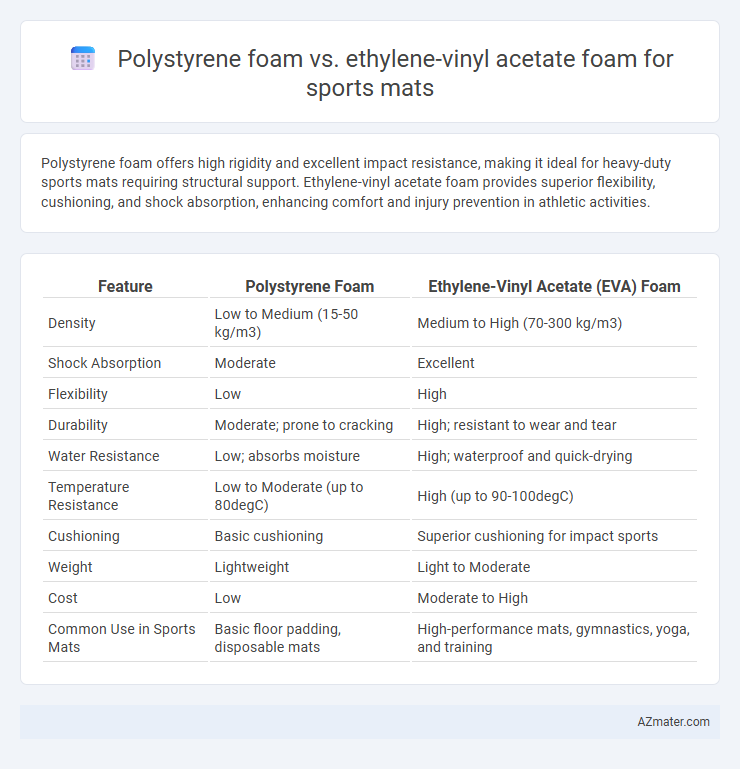Polystyrene foam offers high rigidity and excellent impact resistance, making it ideal for heavy-duty sports mats requiring structural support. Ethylene-vinyl acetate foam provides superior flexibility, cushioning, and shock absorption, enhancing comfort and injury prevention in athletic activities.
Table of Comparison
| Feature | Polystyrene Foam | Ethylene-Vinyl Acetate (EVA) Foam |
|---|---|---|
| Density | Low to Medium (15-50 kg/m3) | Medium to High (70-300 kg/m3) |
| Shock Absorption | Moderate | Excellent |
| Flexibility | Low | High |
| Durability | Moderate; prone to cracking | High; resistant to wear and tear |
| Water Resistance | Low; absorbs moisture | High; waterproof and quick-drying |
| Temperature Resistance | Low to Moderate (up to 80degC) | High (up to 90-100degC) |
| Cushioning | Basic cushioning | Superior cushioning for impact sports |
| Weight | Lightweight | Light to Moderate |
| Cost | Low | Moderate to High |
| Common Use in Sports Mats | Basic floor padding, disposable mats | High-performance mats, gymnastics, yoga, and training |
Introduction to Sports Mat Materials
Sports mats commonly use Polystyrene foam and Ethylene-vinyl acetate (EVA) foam due to their distinct performance characteristics. Polystyrene foam offers lightweight cushioning with high rigidity, ideal for shock absorption in impact sports, while EVA foam provides superior elasticity and durability, enhancing comfort and resistance to wear. Selection between these materials depends on specific sport requirements, balancing firmness and flexibility to optimize athlete safety and performance.
Overview of Polystyrene Foam
Polystyrene foam is a lightweight, rigid material known for its excellent cushioning and impact absorption properties, making it a popular choice for sports mats. It offers high compressive strength and durability, ensuring effective shock protection during athletic activities. Compared to ethylene-vinyl acetate (EVA) foam, polystyrene foam provides superior firmness but less flexibility, ideal for applications requiring stable support and resistance to deformation.
Overview of Ethylene-Vinyl Acetate (EVA) Foam
Ethylene-Vinyl Acetate (EVA) foam is a versatile material widely used in sports mats due to its excellent flexibility, shock absorption, and durability compared to polystyrene foam. EVA foam offers superior resistance to stress cracks and UV radiation, making it ideal for high-impact activities and outdoor use. Its closed-cell structure provides enhanced moisture resistance and cushioning, ensuring athlete safety and prolonged mat lifespan.
Shock Absorption and Cushioning
Ethylene-vinyl acetate (EVA) foam offers superior shock absorption compared to polystyrene foam, making it ideal for sports mats that require effective impact protection. EVA foam provides better cushioning due to its flexibility and resilience, reducing the risk of injury during high-impact activities. Polystyrene foam, while lightweight, is less effective in distributing pressure and absorbs less shock, making it less suitable for prolonged athletic use.
Durability and Longevity Comparison
Polystyrene foam offers high rigidity and resistance to compression, making it durable but prone to cracking under repeated impact. Ethylene-vinyl acetate (EVA) foam provides superior flexibility and resilience, enhancing its longevity by maintaining cushioning properties even after extensive use. For sports mats requiring sustained performance and shock absorption, EVA foam generally outperforms polystyrene foam in durability and long-term comfort.
Comfort and User Experience
Polystyrene foam offers a firm, durable surface ideal for high-impact sports mats but can feel rigid and less forgiving during prolonged use, potentially reducing overall comfort. Ethylene-vinyl acetate (EVA) foam provides superior cushioning and flexibility with excellent shock absorption, enhancing the user experience by minimizing joint stress and improving comfort during extended workouts. The choice between polystyrene and EVA foams directly affects the balance of support and plushness, critical factors in sports mat performance and user satisfaction.
Safety and Impact Protection
Polystyrene foam offers high rigidity and excellent impact absorption, making it ideal for sports mats requiring firm support and shock resistance; however, it is more prone to cracking under extreme stress. Ethylene-vinyl acetate (EVA) foam provides superior flexibility and cushioning, enhancing safety by reducing the risk of injury through better shock dispersion and energy absorption. EVA foam's resilience and non-toxic properties make it a safer choice for prolonged physical activities, whereas polystyrene foam may emit harmful fumes under high temperatures.
Environmental Impact and Sustainability
Polystyrene foam, commonly used in sports mats, poses significant environmental challenges due to its non-biodegradability and difficulty in recycling, leading to long-lasting landfill waste and potential microplastic pollution. Ethylene-vinyl acetate (EVA) foam offers a more sustainable alternative as it is non-toxic, recyclable, and contains fewer harmful chemicals, making it less damaging during production and disposal. However, both materials rely on petrochemical sources, emphasizing the importance of advancing bio-based foam technologies to enhance the overall environmental performance of sports mats.
Cost Effectiveness and Availability
Polystyrene foam offers a cost-effective solution for sports mats due to its low material and manufacturing costs, making it widely available in bulk for large-scale production. Ethylene-vinyl acetate (EVA) foam, while more expensive, provides superior durability and cushioning, which can reduce replacement frequency but may increase initial investment. Availability of polystyrene foam is higher globally, whereas EVA foam supply can be more region-specific and influenced by demand in specialized sports equipment markets.
Conclusion: Choosing the Best Foam for Sports Mats
Ethylene-vinyl acetate (EVA) foam offers superior cushioning, resilience, and moisture resistance, making it ideal for sports mats requiring long-term durability and comfort during high-impact activities. Polystyrene foam is lighter and more cost-effective but lacks the flexibility and shock absorption needed for rigorous sports use, limiting its effectiveness in performance mats. Selecting EVA foam ensures enhanced protection, longevity, and athlete safety, establishing it as the preferred material for high-quality sports mats.

Infographic: Polystyrene foam vs Ethylene-vinyl acetate foam for Sports Mat
 azmater.com
azmater.com